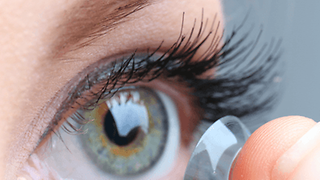There’s often a lot of confusion about what it is, including its effects and treatments. So, to clear things up, this guide will help to demystify the condition and provide practical tips to correct it.
A guide to astigmatism
There’s often a lot of confusion about what it is, including its effects and treatments. So, to clear things up, this guide will help to demystify the condition and provide practical tips to correct it.

What is astigmatism?
Let’s define astigmatism.
Astigmatism is a common eye condition caused by a refractive error in the eye’s lens, which can result in blurred vision. This error happens when the eye’s cornea or lens is irregularly shaped. The condition is easily corrected with contact lenses or glasses.
There are two categories of astigmatism. Corneal astigmatism (also known as regular) which is caused by a distorted cornea and lenticular astigmatism (also known as irregular) which is caused by a distorted lens.
Corneal is the most common form, this occurs when the cornea is irregularly curved in one direction more than the other. The shape of the eye in this case is commonly said to look more like a rugby ball than a football. Lenticular astigmatism can be recognised by an optician from the irregular curvature of the eye’s lens, often in multiple different directions.
Although there are two main reasons or categories for astigmatism there are actually three ways your vision can be affected, they are classified as: myopic (nearsightedness), hyperopic (farsightedness) and mixed (a combination of near and farsightedness).
Astigmatism symptoms
- Blurred vision, short and long
- Eye strain
- Headache
- Squinting
- Difficulty seeing at night, which can affect driving
Astigmatism is usually found alongside other eye conditions notably short-sightedness and long-sightedness.
How to test for astigmatism
If you are experiencing any of these common symptoms or a combination and think you might have astigmatism, simply book an eye test with your optician. You don’t need special equipment or to visit the doctors.
If you’re uncertain and don’t have time for a trip to the optician, you can always do a preliminary test at home. There are two simple tests you can do to determine the level of astigmatism in your eyes, the dial test and the line test, visit vision and eye health to find out for yourself.
Common myths of astigmatism
1. Astigmatism can cause blindness
Astigmatism is not so serious that it causes blindness. However, it can make life harder, as vision can become blurred.
2. Astigmatism is only inherited at birth
While astigmatism can be present at birth, it can also develop at any stage of life. Although optometrists don’t unanimously agree why astigmatism develops, they do agree it’s likely to be passed through family genes. It can also follow an injury, eye surgery or eye disease. Because it can be hereditary, it’s a good idea to test for astigmatism in children at a young age.
3. Reading in the dark or sitting too close to the TV can cause astigmatism
No, it’s a myth. Sitting too close to the TV or reading in the dark will not cause astigmatism, but it can weaken the eyes leading to eyestrain, tiredness and headaches. Read more at essilor.com.
People sometimes ask, ‘can too much screen time damage my eyes?’, sorry the answer is yes. Too much screen time, whether you’re overexposed to white light at work or browsing your mobile at the weekend can lead to digital eye strain. Sadly, it affects children too, especially if they are glued to their tablets for many hours at a time.
4. Astigmatism can correct itself
Despite some online articles claiming otherwise, astigmatism won’t get better over time. Astigmatism, as with any eye condition can worsen with age. Don’t worry there are options to alleviate the condition.
Can astigmatism be corrected with contact lenses?
If you’re here, you’ll be wondering to yourself: ‘can astigmatism be corrected with contact lenses?’. Luckily, the short answer is yes. Specifically, with toric lenses. Toric lenses are shaped to fit an eye with astigmatism, if you have astigmatism, you might find that normal lenses won’t do the trick and move around a bit while you wear them. Toric lenses solve this problem, staying firmly in place - some are even more heavily weighted at the bottom to ensure they don’t move – allowing you undisturbed clear and comfortable vision. One of our top selling toric lenses is 1 Day Acuvue Moist for Astigmatism. If you find your current astigmatism lenses aren’t comfortable, try them today.
Related links
- Check out our full range of Toric Contact Lenses and find the best solution for you.
- Find out more about common vision problems and much more by visiting our Eye care centre.
3

| 5 MIN READ
Summer's finally here. That means it's time to strip off of those clunky old glasses and go naked. We've got 6 great reasons why you should be choosing contact lenses over glasses this summer.

| 5 MIN READ
Find out if contact lenses are a good option for your child. Olympian Katarina Johnson-Thompson started wearing contact lenses at secondary school and has gone on to excel. Find out more about contact lenses for children on our blog.

| 4 MIN READ
Are your contact lenses comfortable enough? You should always want the best for your eyes and your health, here’s a list of situations which might indicate you need to rethink your contact lenses.